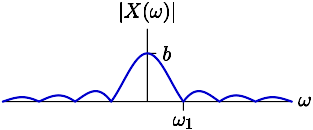Delayed Pulse
Please Log In for full access to the web site.
Note that this link will take you to an external site (https://shimmer.mit.edu) to authenticate, and then you will be redirected back to this page.
Please answer the following questions by entering Python expressions in the boxes provided. Your answers may contain any of the following:
omegarepresents \omegaOMEGArepresents \Omegasinandcosrepresent \sin(\cdot) and \cos(\cdot), respectivelysqrtrepresents the square root functione,1j, andpirepresent e, j, and \pi, respectivelyReandImrepresent {\rm Re}(\cdot) and {\rm Im}(\cdot), respectively
Consider the CT signal x(\cdot) defined by the following plot (you can assume that x(t) = 0 for all t not shown in the plot below):

This function has a Fourier transform given by X(\cdot). A portion of the magnitude of the Fourier transform is shown below:

When entering your answer, you may use t_1 to refer to t_1, t_2 to refer to t_2, and/or a to refer to a.
b =~
When entering your answer, you may use t_1 to refer to t_1, t_2 to refer to t_2, and/or a to refer to a.
\omega_1 =~